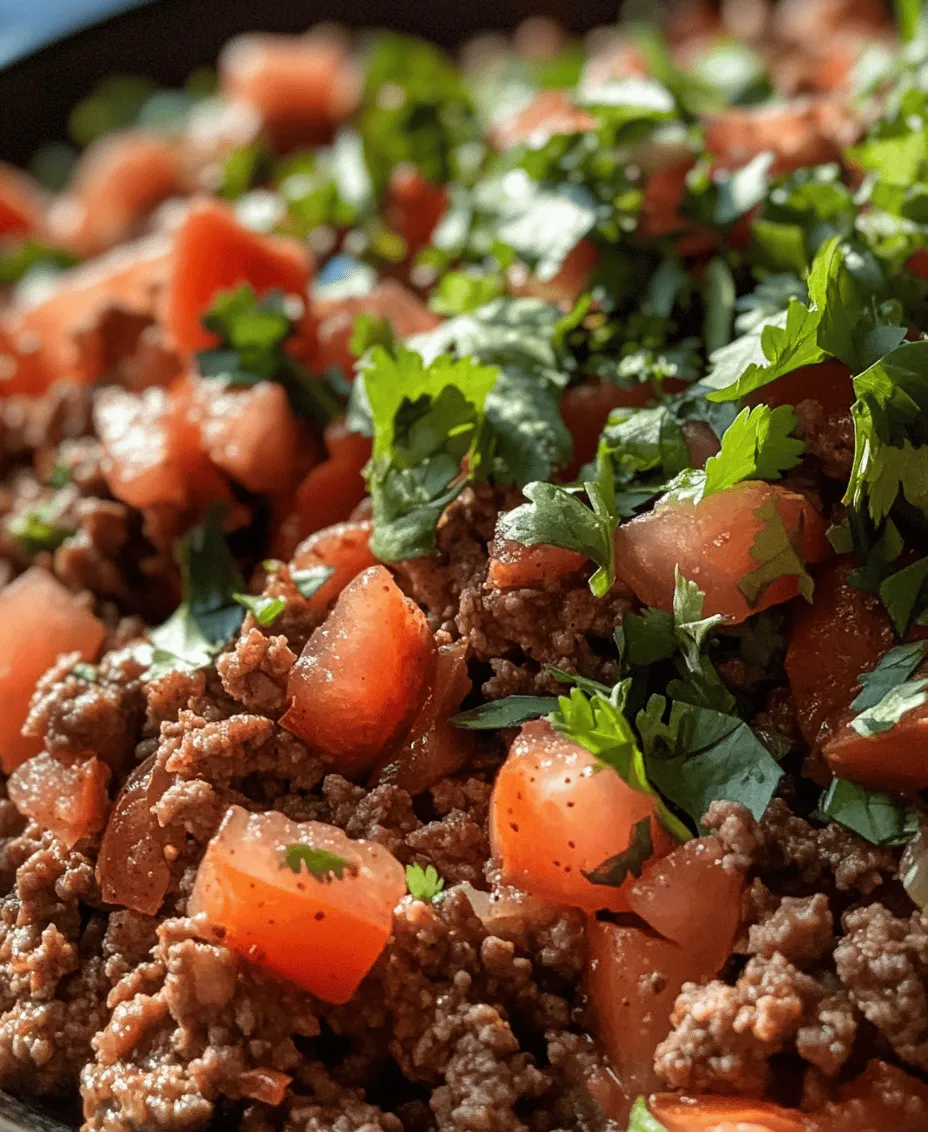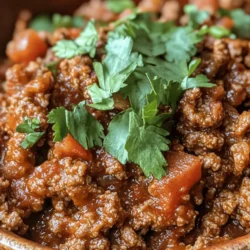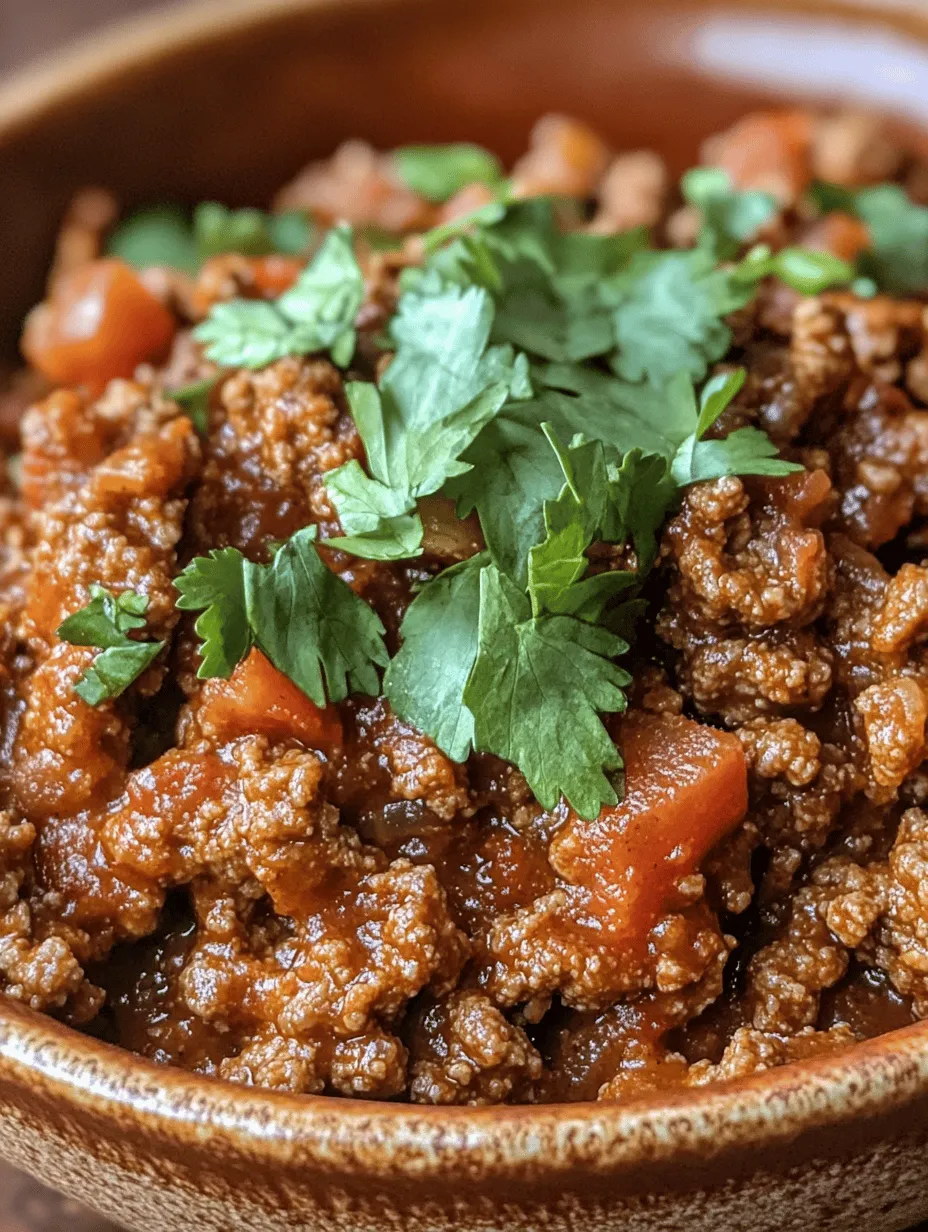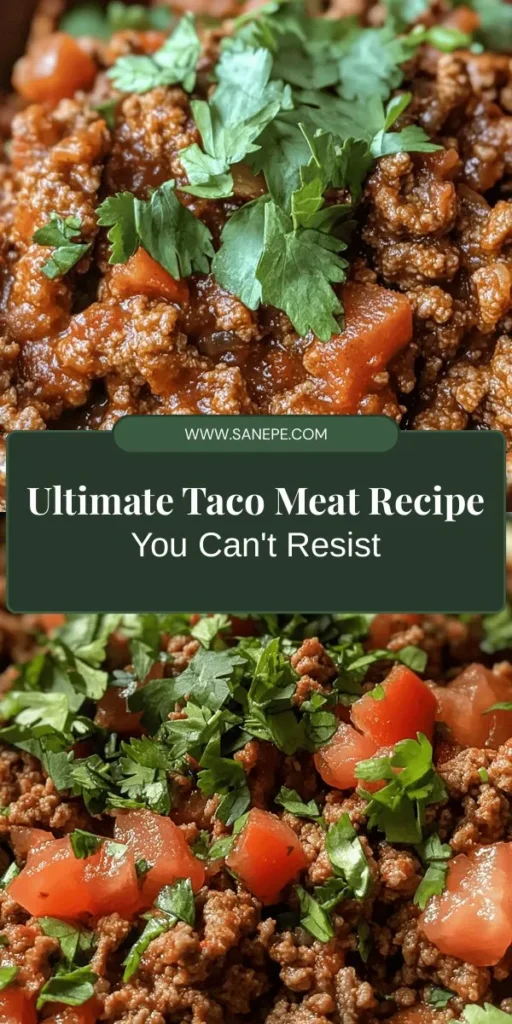Introduction
Tacos are more than just a meal; they are a culinary experience that transcends borders and cultures. From the vibrant streets of Mexico to upscale restaurants around the world, tacos have cemented their place as a beloved dish in various cuisines. They offer a delightful combination of textures, flavors, and colors, making them a go-to choice for casual gatherings, family dinners, and even sophisticated dining experiences. At the heart of every great taco lies its foundation: the taco meat.
A flavorful taco meat base is essential for crafting the perfect taco experience. It serves as the centerpiece around which all other ingredients revolve. Whether you prefer soft tortillas or crunchy shells, the quality of the meat can elevate your taco from ordinary to extraordinary. This recipe promises to deliver a simple yet versatile taco meat that can be used in a variety of ways, from traditional tacos to burritos, nachos, and even taco salads.
In this article, we’ll take you through a detailed, step-by-step guide to creating the ultimate taco meat. With just a handful of ingredients and a few straightforward techniques, you’ll be able to whip up a flavorful base that will leave your taste buds craving more. Let’s dive into the ingredients that make this taco meat a standout.
Understanding the Ingredients
Before we begin, let’s take a closer look at the main ingredients that will bring our taco meat to life. Each component plays a vital role in achieving the perfect balance of flavor and texture.
Ground Meat: Beef vs. Turkey
The backbone of any taco meat recipe is the choice of ground meat. Traditionally, ground beef is the go-to option, renowned for its rich flavor and satisfying texture. However, for those seeking a healthier alternative, ground turkey has become increasingly popular.
Ground turkey is leaner than beef, which can result in a lighter meal. While it may lack some of the robust flavor that beef provides, it absorbs spices and seasonings well, making it a worthy substitute. Ultimately, the decision between ground beef and turkey comes down to personal preference and dietary considerations. Each option will yield delicious results, so feel free to choose based on your taste and nutritional goals.
Fresh Herbs and Vegetables
No taco meat is complete without the aromatic foundation of fresh herbs and vegetables. In this recipe, we will use onions and garlic. These two ingredients not only add essential flavor but also contribute to the overall aroma of the dish.
Onions, when sautéed, develop a sweet and savory profile that enhances the meat. They should be cooked until translucent and slightly caramelized, which brings out their natural sugars. Garlic, on the other hand, adds a punch of flavor. However, it’s crucial to cook garlic properly to avoid bitterness. Adding it at the right moment during cooking ensures that it infuses the meat with its unique taste without overpowering the dish.
Spices: The Flavor Makers
The spices used in our taco meat recipe are what truly set it apart. Here’s a breakdown of the key spices we will use:
– Chili Powder: This spice blend typically includes ground chili peppers, garlic powder, and various spices. It brings warmth and depth to the dish.
– Cumin: Known for its earthy flavor, cumin adds a distinctive aroma that is a hallmark of Mexican cuisine. It complements the other spices beautifully.
– Paprika: This spice adds a mild sweetness and vibrant color to the meat. Smoked paprika can also be used for a deeper, smoky flavor.
– Oregano: A staple in many savory dishes, oregano contributes a herbal note that balances the richness of the meat.
– Cayenne Pepper: For those who like a bit of heat, cayenne pepper can be added to taste. It provides a spicy kick that elevates the overall flavor profile.
Diced Tomatoes and Broth
To keep our taco meat juicy and flavorful, we will incorporate diced tomatoes and broth. Diced tomatoes add moisture and a touch of acidity, which helps to brighten up the dish. Using canned tomatoes is a convenient option, as they are available year-round and can save preparation time.
Additionally, broth—whether chicken, beef, or vegetable—will provide depth and enhance the flavor of the meat. It’s important to choose a broth that complements your choice of meat, as this will ensure a harmonious blend of flavors.
Preparation Steps for Taco Meat
Now that we have all our ingredients ready, let’s get started on the preparation steps that will lead to the ultimate taco meat.
Step 1: Preparing the Skillet
Begin by selecting a large skillet or frying pan. Non-stick or cast iron skillets work particularly well for this recipe. Place the skillet over medium heat and allow it to warm up for a minute or two. A preheated skillet ensures that the meat browns properly, developing a rich flavor and texture.
Step 2: Sautéing the Onion
Once the skillet is hot, add a drizzle of olive oil or your preferred cooking oil. About one tablespoon is sufficient for this amount of meat. After the oil has heated, add the diced onion. Sauté the onion for about 5-7 minutes, stirring occasionally, until it becomes translucent and slightly caramelized.
Cooking the onion until it is tender and aromatic is crucial, as it lays the foundation for the flavors in our taco meat. The natural sweetness of the onion will enhance the overall taste of the dish.
Step 3: Cooking the Garlic
Next, it’s time to add the minced garlic. It’s essential to add garlic after the onion has begun to soften, as garlic cooks quickly and can easily burn. Sauté the garlic for about 30 seconds to 1 minute, just until fragrant. Keep an eye on it and stir continuously to prevent burning, as burnt garlic can impart a bitter taste to your taco meat.
Step 4: Browning the Meat
Now, it’s time to introduce the ground meat to the skillet. Add the meat to the pan, breaking it apart with a spatula or wooden spoon as you mix it with the onion and garlic. Allow the meat to cook undisturbed for a few minutes to achieve a nice browning. This step is crucial, as browning the meat enhances its flavor through the Maillard reaction, creating a rich, complex taste.
Continue to cook the meat, stirring occasionally, until it is fully browned and no longer pink. This should take about 5-7 minutes. If you’re using ground turkey, be aware that it may not brown as deeply as beef, but it will still develop a pleasing texture and flavor.
Step 5: Seasoning the Meat
Once the meat is browned, it’s time to season it for maximum flavor. Sprinkle in the chili powder, cumin, paprika, oregano, and cayenne pepper (if using). Use your spatula to mix the spices thoroughly into the meat, ensuring even distribution.
Cooking the spices along with the meat allows them to bloom, releasing their essential oils and intensifying their flavors. Be sure to season with salt and pepper to taste, as this will elevate the overall dish.
Step 6: Simmering for Flavor Development
The final step in our preparation process is to add the diced tomatoes and broth to the skillet. Pour in the tomatoes, including their juices, and add about half a cup of broth. Stir everything together, allowing the mixture to come to a gentle simmer.
Simmering is crucial for flavor development. It allows the meat to absorb the flavors of the spices and the acidity of the tomatoes, resulting in a cohesive and delicious taco filling. Let the mixture simmer for about 10-15 minutes, stirring occasionally, until the liquid has reduced slightly and the mixture has thickened.
During this time, taste the taco meat and adjust the seasoning if necessary. If you prefer a spicier kick, feel free to add more cayenne or a dash of hot sauce to suit your palate.
By following these steps, you will have created a flavorful taco meat that is ready to be used in your favorite taco recipes. Stay tuned for the next part, where we’ll explore the flavor profile of our taco meat and discuss potential adjustments to cater to your personal taste preferences.

Tasting and Adjusting Seasoning
Once you’ve prepared your taco meat, it’s essential to taste and adjust the seasoning to ensure that each bite is packed with flavor. Start by sampling a small spoonful to gauge its initial taste. If you find it lacking, consider the following tips for balancing flavors:
1. Salt: This is often the first step in enhancing flavor. A pinch of salt can amplify other seasonings, so taste your taco meat and add salt gradually, mixing well after each addition.
2. Acidity: Sometimes, a bit of acidity can brighten the dish. Consider adding a splash of lime juice or a dash of vinegar to enhance the overall taste. Acidic ingredients can cut through the richness of the meat and provide a refreshing contrast.
3. Heat: If your taco meat is not spicy enough, you can add crushed red pepper flakes or a few dashes of your favorite hot sauce. If you prefer a milder flavor, start with just a small amount and gradually increase it until it reaches your desired spice level.
4. Sweetness: A hint of sweetness can counterbalance the spice and acidity. Consider adding a teaspoon of sugar, honey, or agave syrup. This can help achieve a well-rounded flavor profile.
5. Umami: For an extra depth of flavor, consider incorporating a tablespoon of soy sauce or Worcestershire sauce. These ingredients can enhance the savory notes of your taco meat.
Personalizing the Spice Level
Adjusting the spice level to suit individual preferences is vital when preparing taco meat. Here are a few strategies to customize the heat:
1. Pepper Varieties: Experiment with different types of peppers. Jalapeños, serranos, and even poblano peppers can vary in heat. Choose fresh peppers based on your spice tolerance. Removing the seeds and membranes will also reduce the heat.
2. Dried Spices: If you prefer a milder taco meat, consider using less cayenne pepper or chili powder. Start with half the recommended amount, and then taste and adjust as necessary.
3. Heat Sources: Incorporate different heat sources like chipotle in adobo sauce for a smoky kick or use salsa verde for a green, spicy alternative. These elements can introduce distinct flavor profiles alongside heat.
4. Serving Options: Offer hot sauce or spicy salsa on the side. This allows guests to personalize their tacos according to their spice preferences, making the meal more inclusive and enjoyable.
Enhancing Flavor
To elevate the flavor of your taco meat further, consider these simple enhancements:
– Lime Juice: A squeeze of fresh lime juice just before serving can add brightness and zest to your taco meat. The acidity of lime cuts through the richness and brings a fresh flavor that complements the other ingredients beautifully.
– Hot Sauce: For those who enjoy heat, a drizzle of your favorite hot sauce can take your taco meat to the next level. Whether you prefer a vinegar-based sauce or a smoky chipotle sauce, this addition enhances both flavor and excitement.
– Fresh Herbs: Chopped cilantro or green onions can add freshness and a burst of color when sprinkled over the finished product. These herbs not only enhance the visual appeal but also provide a lovely contrast to the seasoned meat.
Serving Suggestions
Once your taco meat is perfectly seasoned, it’s time to think about presentation. Here are some creative ideas for serving your taco meat:
Taco Shells and Tortillas:
– Traditional Hard Shells: Load your taco meat into crispy hard shells. Top with shredded lettuce, tomatoes, and cheese for a classic presentation.
– Soft Tortillas: For a more authentic experience, use warm flour or corn tortillas. Fill them with taco meat and fold them over, allowing guests to add their toppings.
Popular Toppings:
1. Cheese: Sprinkle shredded cheddar, Monterey Jack, or crumbled queso fresco over your tacos for a creamy, savory addition.
2. Lettuce: Shredded romaine or iceberg lettuce adds crunch and freshness.
3. Salsa: Offer a variety of salsas, from mild to hot, so guests can customize their flavor experience.
4. Avocado: Slices of ripe avocado or guacamole can add a creamy texture and balance the spices.
5. Sour Cream: A dollop of sour cream provides a cooling effect and richness.
Side Dish Suggestions:
To create a complete taco experience, consider serving your taco meat alongside delightful side dishes:
– Mexican Rice: Fluffy rice seasoned with cumin and lime pairs well with tacos, absorbing the juices and enhancing the meal.
– Refried Beans: Rich and creamy, refried beans are a classic accompaniment that adds protein and flavor.
– Simple Salad: A fresh salad with greens, tomatoes, and a light vinaigrette can balance the richness of the taco meat.
Cultural Significance of Tacos
Tacos hold a special place in Mexican cuisine and culture, representing not just a meal but a way of life. Here’s a glimpse into their significance:
History of Tacos:
Tacos have origins that trace back to the indigenous peoples of Mexico, who would use corn tortillas to wrap various fillings. The word “taco” is believed to derive from the silver mines in Mexico, where workers would use tortillas to hold their food, making it easy to eat on the go. Over the years, tacos have evolved, with countless regional variations emerging.
Tacos in Social Gatherings:
Tacos are often the centerpiece of social gatherings, from family dinners to festive celebrations. In Mexico, tacos are a staple at street food stalls and restaurants, enjoyed by individuals and families alike. They symbolize community and sharing, making them perfect for gatherings where people come together to break bread.
Regional Variations:
The preparation of taco meat varies widely across Mexico. For example, in the northern states, you might find tacos filled with grilled beef, while in the southern regions, cochinita pibil (slow-roasted pork) is popular. Each region’s unique ingredients and cooking methods contribute to the rich tapestry of taco culture.
Storage and Reheating
If you have leftover taco meat, proper storage and reheating techniques are essential for maintaining flavor and texture.
Storing Leftover Taco Meat:
– Allow the taco meat to cool completely before transferring it into an airtight container.
– Store the meat in the refrigerator for up to 3-4 days. For longer storage, consider freezing it for up to 3 months. Make sure to label the container with the date for easy tracking.
Reheating Taco Meat:
– To reheat taco meat, place it in a skillet over medium heat. Add a splash of water or broth to prevent it from drying out, stirring occasionally until heated through.
– Alternatively, you can microwave the meat in short intervals, stirring in between to ensure even heating.
Repurposing Leftover Taco Meat:
Leftover taco meat is incredibly versatile and can be repurposed into various dishes:
– Nachos: Layer tortilla chips with taco meat, cheese, and toppings for a delicious nacho platter.
– Burritos: Roll taco meat with beans, rice, and cheese in a large tortilla for a hearty burrito.
– Quesadillas: Use taco meat as a filling in quesadillas, adding cheese and grilling until golden brown.
Conclusion
Creating homemade taco meat is not just about the dish itself; it’s about the joy of cooking and sharing with others. This ultimate taco meat recipe serves as a foundation for endless customization and creativity. Whether you prefer it spicy or mild, traditional or with a twist, the beauty of taco preparation lies in its adaptability.
Encourage your family and friends to join in the fun, experimenting with flavors, toppings, and side dishes. As you embark on this culinary journey, you’ll discover that the perfect taco is not just a meal but a celebration of culture, community, and creativity. Enjoy making this taco meat recipe a personal favorite, and don’t hesitate to make it your own!


